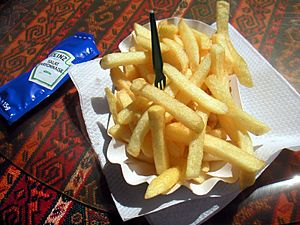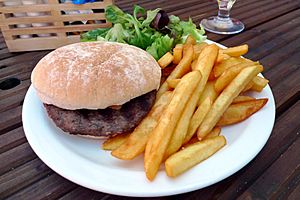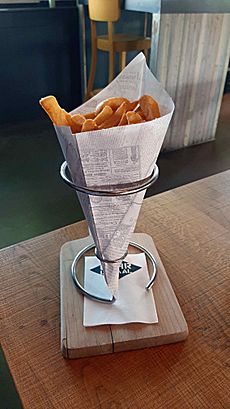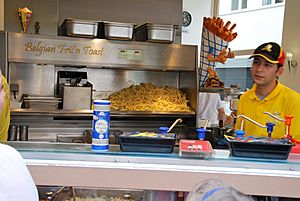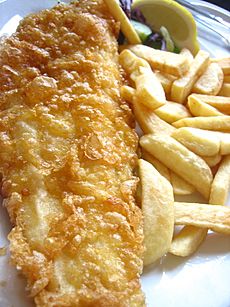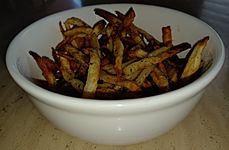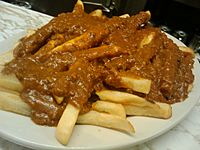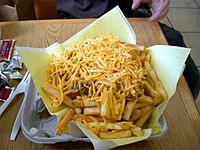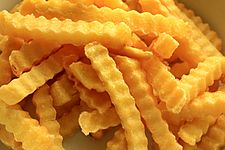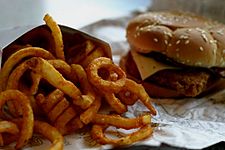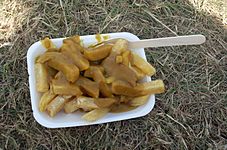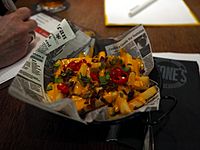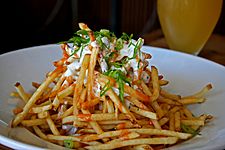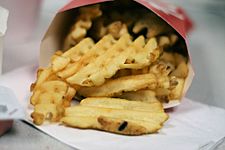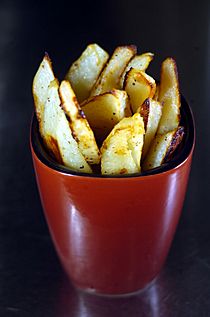French fries facts for kids
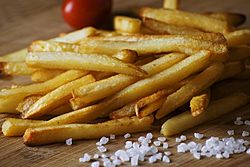 |
|
| Alternative names | Chips, finger chips, fries, frites, hot chips, steak fries, slap chips |
|---|---|
| Course | Side dish or snack, rarely as a main dish |
| Serving temperature | Hot |
| Main ingredients | |
| Variations | Curly fries, shoestring fries, steak fries, sweet potato fries, chili cheese fries, poutine, crinkle cut fries, waffle fries |
| Other information | Often served with salt and ketchup, mayonnaise, vinegar, barbecue sauce or other sauce |
French fries are a super popular snack or side dish made from potatoes. They are known by many names around the world! In North America, people call them french fries or just fries. But in places like the United Kingdom, Australia, and New Zealand, they are usually called chips. In India, they might be called finger chips.
No matter what you call them, these tasty treats are made by cutting potatoes into long, thin strips. Then, they are deep-fried until they are golden and crispy. You can eat them soft or crunchy, and they are almost always served hot. French fries are a common sight on menus at fast food restaurants, diners, and even pubs. They are often served with salt and a dipping sauce like ketchup or mayonnaise. Sometimes, they are even topped with things like chili and cheese!
Contents
How to Make French Fries
The most common way to cook french fries is by deep frying them. This means they are fully covered in hot oil.
First, potatoes are cut into even strips. You can leave the skin on or peel it off. After cutting, the potato strips are often rinsed in cold water. This helps remove extra starch from the surface, which makes the fries crispier. Then, they are dried very well.
Many chefs use a "two-bath" method to make the best fries.
- The first bath is in hot oil (around 160°C or 320°F). This cooks the inside of the potato until it's soft. You can do this step ahead of time.
- The second bath is in very hot oil (around 190°C or 375°F). This step is quick and makes the outside of the fries super crispy and golden.
After frying, the fries are drained and usually salted right away. Most french fries you find in stores or fast food restaurants are made from frozen potatoes that have already been partly cooked.
Where Did French Fries Get Their Name?
In the United States and Canada, the name "french fries" is used for all kinds of fried potato sticks. You might hear names like curly fries or shoestring fries for different shapes.
In the United Kingdom, Australia, and other places, they are called chips. These chips are usually cut thicker than what Americans call french fries. If they are very thin, they might still be called "french fries" or "skinny fries" to tell them apart from the thicker chips. In North America, thicker chips might be called "steak fries." It can be a bit confusing!
The word "french fried potatoes" first appeared in an English cookbook in 1856. It described thin slices of potato that were shallow-fried. It's not totally clear when the deep-fried potato sticks we know today first appeared. Some people think the name "french fries" came from American soldiers in World War I. They were in Belgium, where French was spoken, and thought the chips were a French dish. However, the name "french fries" was used in the US even before the war.
The Origin Story: France or Belgium?
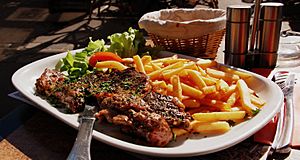
There's a friendly debate between France and Belgium about who invented french fries!
Some historians say that fries might have been invented in Spain. Potatoes first arrived in Europe in Spain from the New World. One expert even suggests that Saint Teresa of Ávila from Spain might have cooked the first french fries.
However, many food historians believe that fries are from France. They say fries were first mentioned in a Parisian book in 1775. The first recipe for modern french fries appeared in a French cookbook in 1795. Fries became a very popular dish in Paris in the 1800s. A Bavarian musician named Frédéric Krieger learned to make fries in Paris in 1842 and brought the recipe to Belgium in 1844.
From the Belgian side, there's a story that people in the Meuse valley in Belgium were deep-frying potatoes before 1680. They supposedly did this as a substitute for fried fish when the rivers were frozen. However, there's no real proof for this story, and potatoes didn't even arrive in that area until much later. Also, it would have been too expensive for farmers to use so much oil to fry potatoes back then.
So, the debate continues, but both countries love their fries!
French Fries Around the World
French fries are a global sensation! Here's how they are enjoyed in different places:
Fries in Belgium and the Netherlands
In Belgium, fries are called frieten (in Dutch) or frites (in French). They are a national snack and a big part of dishes like Moules-frites (mussels and fries) or Steak frites (steak and fries). In Belgium, fries are sold in special shops called friteries. They are often served in a paper cone with a big dollop of sauce, usually mayonnaise.
Fries in France
In France, fried potatoes are formally called pommes de terre frites, but people usually just say pommes frites or frites. Very thin fries might be called aiguillettes or allumettes. A popular dish in France is steak frites, which is steak served with thin french fries.
Fries in Germany
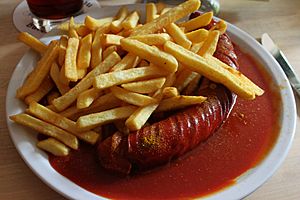
In Germany, fries are known as Pommes frites or just Pommes. They are often served with ketchup or mayonnaise. A very popular German street food is currywurst, which is a sausage with a spiced ketchup sauce, often served with fries.
Fries in the United Kingdom
In the UK, the standard deep-fried potatoes are called chips. They are usually cut thicker than American french fries. British chips are a key part of the famous fast food dish fish and chips. The first chip shop in the UK opened in the 1850s.
Fries in the United States and Canada
In the US, french fries are one of the most popular side dishes. They are commonly served with burgers and other fast food meals. The average American eats about 30 pounds of french fries each year!
In Canada, especially in Quebec, fries are the main ingredient in a famous dish called poutine. Poutine is made with french fries topped with cheese curds and brown gravy. It's a delicious and unique way to enjoy fries!
Fries in Other Countries
- In Spain, they are called patatas fritas. A different version, patatas bravas, are chunky fried potatoes with a spicy tomato sauce.
- In South Africa, a popular soft and soggy version called "slap-chips" is soaked in white vinegar. These are often served with deep-fried fish or in a sandwich called a Gatsby.
- In Japan, Furaido poteto (fried potato) is a standard fast food side. You can even find okonomiyaki fries, which are topped with special sauces and seasonings.
Different Kinds of French Fries
French fries come in many fun shapes and with different toppings! Here are some examples:
- Air-fried fries – cooked in an air fryer with less oil.
- Carne asada fries – covered with grilled meat, guacamole, sour cream, and cheese.
- Cheese fries – fries covered with melted cheese.
- Chili cheese fries – fries covered with chili and cheese.
- Crinkle-cut fries – also called "wavy fries," cut with a special ridged shape.
- Curly fries – shaped like spirals, made with a special slicer.
- Curry chips – fries covered in curry sauce.
- Dirty fries – fries covered in melted cheese and toppings like bacon or pulled pork.
- Oven fries – cooked in the oven instead of deep-fried.
- Potato wedges – thick, wedge-shaped fries with the skin left on.
- Poutine – fries topped with cheese curds and gravy.
- Shoestring fries – very thin-cut fries.
- Steak fries – thick-cut fries.
- Sweet potato fries – made from sweet potatoes instead of regular potatoes.
- Tornado fries – spiral-cut potatoes on a skewer, then deep-fried.
- Waffle fries – lattice-shaped fries.
What to Eat with Fries
Fries are often served with many different sauces and toppings. Some popular choices include:
- Salt and vinegar
- Ketchup
- Mayonnaise
- Barbecue sauce
- Gravy
- Cheese (grated or melted)
- Chili
- Ranch dressing
- Aioli (a garlic mayonnaise)
- In Australia, chicken salt is a popular seasoning.
Are French Fries Healthy?
French fries are mostly made of carbohydrates (from the potato) and fat (from the frying oil). They almost always have salt added. For example, a large serving of fries at a fast food restaurant can have about 510 calories.
Some health experts say that french fries are not the healthiest food. This is because they are deep-fried, salted, and often lose some of their nutrients when the skin is removed. They are usually seen as a treat or a side dish, not a main meal. Eating them sometimes is fine, but it's best not to have them every day.
In the past, some restaurants used animal fats or oils that contained trans fats, which are not good for your heart. But now, many places use vegetable oils without trans fats.
French fries can contain something called acrylamides, which form when starchy foods are cooked at high temperatures. Scientists are still studying if acrylamides affect people's risk of getting cancer. Cooking fries in the oven at a lower temperature can help reduce the amount of acrylamides.
Fries and the Environment
A study in 2022 looked at the environmental impact of many different foods. It found that french fries actually have a lower environmental impact compared to many other foods. This means that making and eating french fries might be better for the planet than some other food choices.
See also
 In Spanish: Papas fritas para niños
In Spanish: Papas fritas para niños


